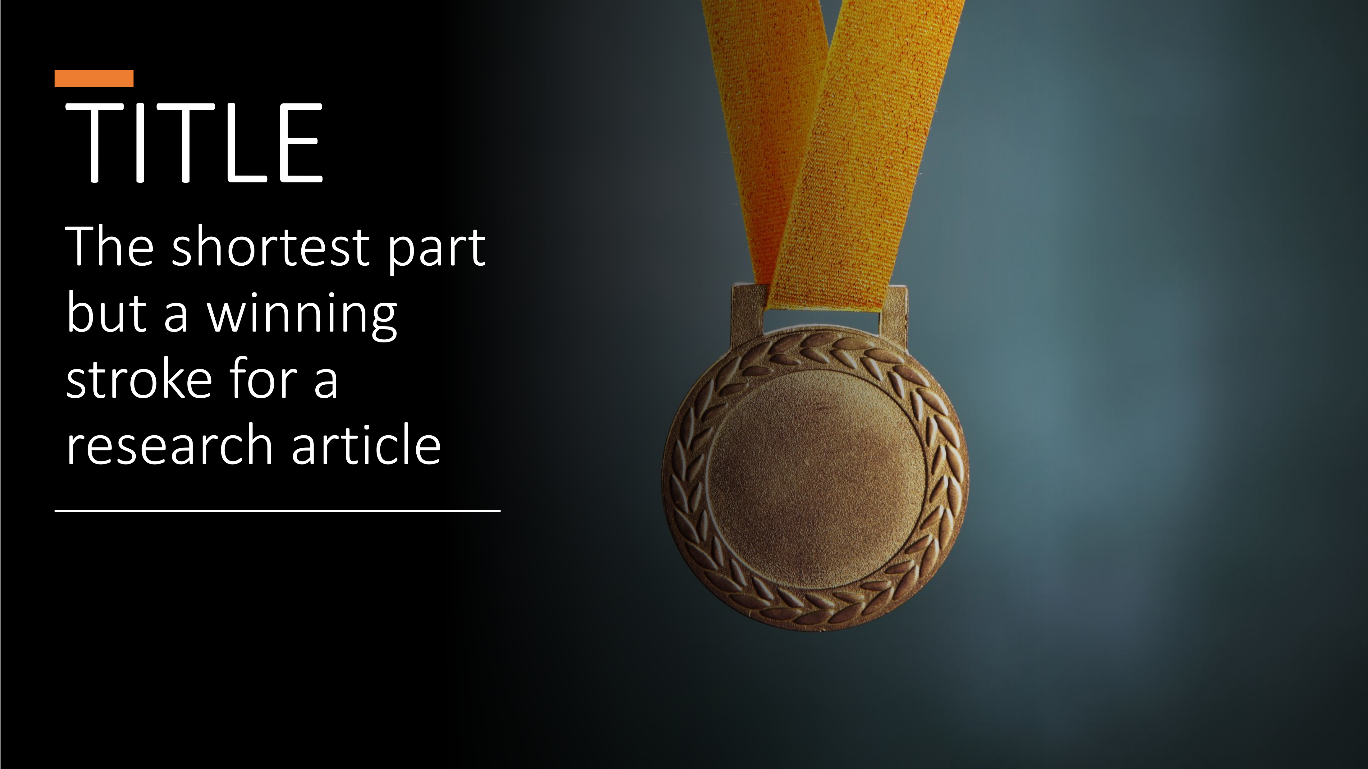Structure of a research paper: Title and Authors
Category:
For authors
Date of publications:
01.11.2024
Views:
103

The title is the first thing readers look at. When searching for the right article, readers look in the following order: "Title" - "Abstract" - "Results (tables and figures)" - "Full text of the paper". On average, the number of readers who go from one section to another in this sequence decreases by 10 times. So how to make an paper more attractive with the help of a title? Let's take a closer look.
Accordingly, we can draw the following conclusions:
Thus, it turns out that one person reads the entire paper for every 1,000 who read the headline. Headlines are read not only by scientists "scanning" the content of a journal, but also by those who look for relevant papers in secondary sources, where the title and author of the paper are always given, but the reference list may be missing. The title may be reprinted in reference and subject indexes, stored in bibliographic databases and cited in other papers. Therefore, the title is an extremely important component of the paper.
A well-designed title attracts readers who might have missed the research paper and can help future researchers find important information.
The title of a research paper should fulfil the following requirements:
Most journals allow and request so-called 'Running Heads' (Running Heads). These are an abbreviated title that will be printed as a caption on all or alternate pages. The journal's guidelines specify the requirements for Running Heads and the maximum number of characters allowed, including spaces. The author should ensure that his/her title matches the content of the paper, especially for review articles and book chapters where the reader's attention needs to be drawn.
As for the list of Authors, they are listed in logical order of importance of their contribution to the work. The person listed first is considered the senior author (unless otherwise stated); other authors may be listed according to the importance of their contribution. Listing authors in alphabetical order is an old practice that journals no longer follow.
Usually the first author listed is the doctoral student whose thesis forms the basis of the article; the second author is his or her supervisor.
The person to whom questions about the article should be addressed (*Corresponding Author) is usually marked with an *.
The list of authors (who should be listed in sequence) can be a complex and contentious issue, leading to unwanted controversy and violating the high ethical standards to which scientists must adhere. Sometimes the head of the laboratory or director of the institute where the work was done insists on being listed as the author of all papers produced by that organisation. Although this is undesirable, he should be listed as the final author - if this is mandatory.
Authors' names should be accurate to ensure correct identification and should be accompanied by an address, including an email address, given in accordance with the journal's formatting requirements. Opposite the author's name, the institution where the author worked during the period described in the paper should be indicated, even if the author left the institution after completing the work (which is typical for doctoral students and trainees); in such cases, the current address of the author with proper identification should be given.
Accordingly, we can draw the following conclusions:
- only one out of 10 readers who look at the title reads the abstract;
- only one out of every 10 readers who read the abstract goes to the "Results" section, paying special attention to "Tables and Figures";
- only one out of every 10 readers who read "Results" reads the whole article.
Thus, it turns out that one person reads the entire paper for every 1,000 who read the headline. Headlines are read not only by scientists "scanning" the content of a journal, but also by those who look for relevant papers in secondary sources, where the title and author of the paper are always given, but the reference list may be missing. The title may be reprinted in reference and subject indexes, stored in bibliographic databases and cited in other papers. Therefore, the title is an extremely important component of the paper.
A well-designed title attracts readers who might have missed the research paper and can help future researchers find important information.
The title of a research paper should fulfil the following requirements:
- contain as few words as possible: many journals limit the titles of research papers to 12 words;
- accurately reflect the topic;
- specifically describe the content of the paper;
- do not contain abbreviations, formulas and slang expressions;
- do not use verbs;
- exclude phrases such as "Some notes on ...", "Observations on ...", "A study on ...", "A study on ..." and "The effect of ...";
- the title should not be catchy, as in advertising slogans (avoid statements such as "Agroforestry can stop deforestation");
- state the subject of the research, not its results;
- adhere to the stylistic preferences of the target journal, study them in advance.
Most journals allow and request so-called 'Running Heads' (Running Heads). These are an abbreviated title that will be printed as a caption on all or alternate pages. The journal's guidelines specify the requirements for Running Heads and the maximum number of characters allowed, including spaces. The author should ensure that his/her title matches the content of the paper, especially for review articles and book chapters where the reader's attention needs to be drawn.
As for the list of Authors, they are listed in logical order of importance of their contribution to the work. The person listed first is considered the senior author (unless otherwise stated); other authors may be listed according to the importance of their contribution. Listing authors in alphabetical order is an old practice that journals no longer follow.
Usually the first author listed is the doctoral student whose thesis forms the basis of the article; the second author is his or her supervisor.
The person to whom questions about the article should be addressed (*Corresponding Author) is usually marked with an *.
The list of authors (who should be listed in sequence) can be a complex and contentious issue, leading to unwanted controversy and violating the high ethical standards to which scientists must adhere. Sometimes the head of the laboratory or director of the institute where the work was done insists on being listed as the author of all papers produced by that organisation. Although this is undesirable, he should be listed as the final author - if this is mandatory.
Authors' names should be accurate to ensure correct identification and should be accompanied by an address, including an email address, given in accordance with the journal's formatting requirements. Opposite the author's name, the institution where the author worked during the period described in the paper should be indicated, even if the author left the institution after completing the work (which is typical for doctoral students and trainees); in such cases, the current address of the author with proper identification should be given.
Share post


